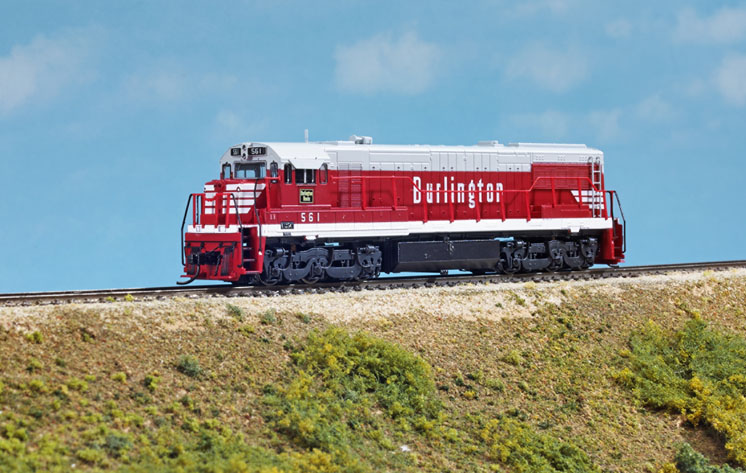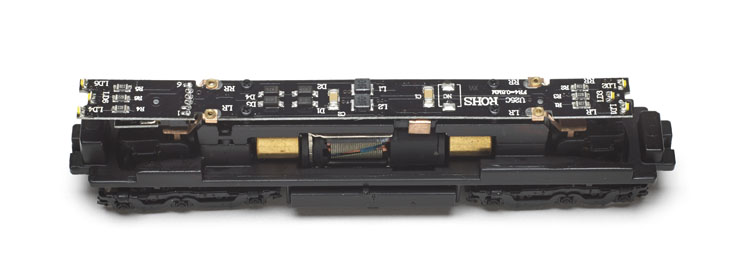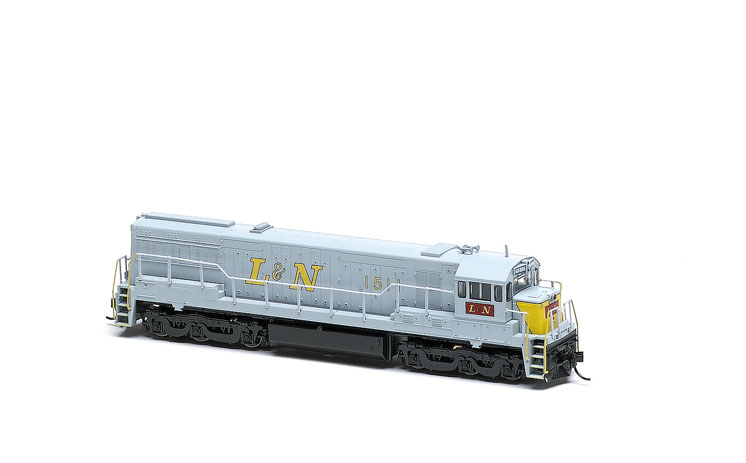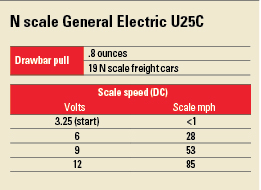An old name has returned to N scale with a new model of General Electric’s U25C. Arnold, now part of the Hornby America family, was an early N scale manufacturer, but this smooth-running model is anything but a throwback.
The prototype. General Electric broke into the mainline diesel market in 1960 with its U25B. Several railroads came to the manufacturer looking for a six-axle variant of the locomotive, and the U25C was the response. All told, there were 113 of the 2,500-hp road freighters built over a two-year production run from September 1963 until December 1965. A few of the later U25C diesels had their engines rebuilt to 2,800 hp, foreshadowing the successor U28C.
The first four and last three U25Cs went to Oro Dam Constructors, which hauled fill during the building of the massive earthen Oroville Dam across the Feather River in California. Other original owners were Northern Pacific; Atlantic Coast Line; Pennsylvania; Louisville & Nashville; Chicago, Burlington & Quincy; and Lake Superior & Ishpeming. Mergers saw U25Cs serving on Burlington Northern, Penn Central, Conrail, and Seaboard Coast Line. The last U25Cs worked for the LS&I in the mid-1980s.
The model. Arnold’s U25C is powered by a can motor with twin flywheels mounted to a die-cast metal frame. Universal joints and worm gears drive all six axles. The axles were a little tight in gauge, measuring .296″ instead of the National Model Railroad Association-standard .301″ and just beyond the .004″ tolerance. But our sample performed smoothly and didn’t have any derailments due to gauge. One wheel on each center axle is fitted with a traction tire. That and a weight screwed to the top of the frame help with pulling power. A printed-circuit (PC) board is mounted on top of the weight. The PC board has a dummy plug that can be replaced with a European-style plug-in Digital Command Control decoder. Examples that fit include the Digitrax DZ126IN or DZ146 and the Train Control Systems EUN651, which all use an NEM 6-pin plug.
The plastic body shell, which was within scale inches of dimensions from the Simmons-Boardman 1966 Car and Locomotive Cyclopedia of American Practice, is held on by the coupler pockets. After removing the small screws, the pockets pull out the front of the pilots, and the shell can be removed from the frame. But be careful! The coupler springs put so much tension on the parts that once they were free of the pilot, the coupler parts flew off to the nether reaches of our workshop.
The body shell is the later production type with screens in place of louvers on the equipment doors behind the cab and with air tanks moved from the ends of the fuel tank to inside the carbody.
When handling the locomotive, I had to take particular care of the delicate molded plastic handrails. It was easy to dislodge them, and it was difficult to get them back in the holes near the steps.Our sample was decorated in the Chicago, Burlington & Quincy’s Chinese Red and gray scheme. The paint was opaque with sharp separations between the colors. The lettering is in the correct fonts, and was legible except for the builder’s plate on the sill. There were a few gaps in the burlington lettering where it crossed door hinges on the side of the long hood.
Separate detail parts include multiple-unit hoses, uncoupling levers, horn, firecracker antenna, cab sunshades, and a ladder on the rear of the long hood. The truck sideframes are one piece and include speed-recorder details on the fireman’s side. The walkways have a dimple pattern that mimics the diamond tread pattern found on full-size locomotives. The model has directional headlights and number boxes that are always illuminated regardless of which way the locomotive is running.
We also received a Louisville & Nashville version that was prototypically detailed and decorated.
Is it moving? The Arnold U25C didn’t start moving until there was a little more than 3V flowing, but then, it was hard to tell it was moving. I was impressed by how smoothly the model crept along at less than 1 scale mph, too slow for our digital speedometer to measure. At 12V, it reached 85 scale mph, a little above the prototype’s top speed of 70 mph with a 74:18 gear ratio.
The locomotive registered .8 ounce of drawbar pull, which equates to 19 freight cars on straight and level track, but in testing on our 2015 Red Oak N scale Model Railroader project layout, it was able to pull 27 cars around the 13″-radius curves of the layout.
The U-boat had no trouble negotiating the layout’s Peco no. 6 turnouts or heading down the spur to the stockyard, with its 93⁄4″ radius curve. Of course, a large locomotive like the U25C looks better on larger-radius curves.
Although there weren’t a lot of U25Cs built, some popular railroads owned them, and the smooth operation of this locomotive makes it an attractive candidate for any layout set in the latter half of the 20th century. Welcome back, Arnold!
Manufacturer
Hornby America Inc.
3900-C2 Industry Drive East
Fife, WA 98424
www.hornby.com/us-en/
Era: 1963 to mid-1980s
Road names: Chicago, Burlington & Quincy; Northern Pacific; Louisville & Nashville; Conrail; Burlington Northern, two road numbers each
Features
▪▪All-wheel drive
▪▪DCC-ready to accept 6-pin decoder
▪▪Die-cast metal chassis
▪▪Five-pole can motor with flywheels
▪▪Knuckle couplers mounted at correct height
▪▪Weight: 3.7 ounces

















